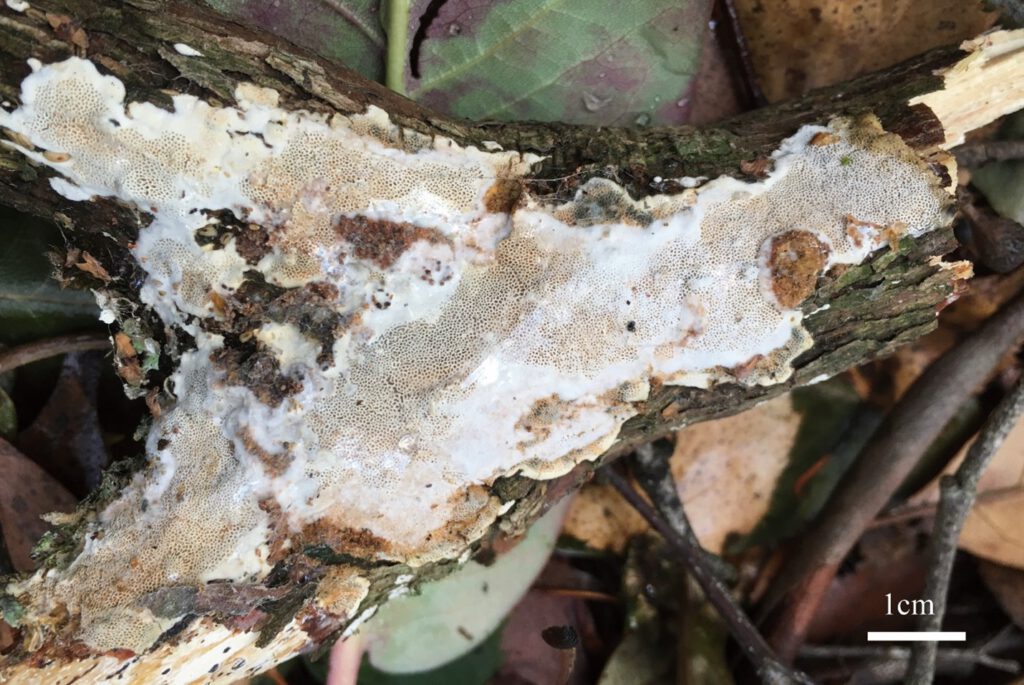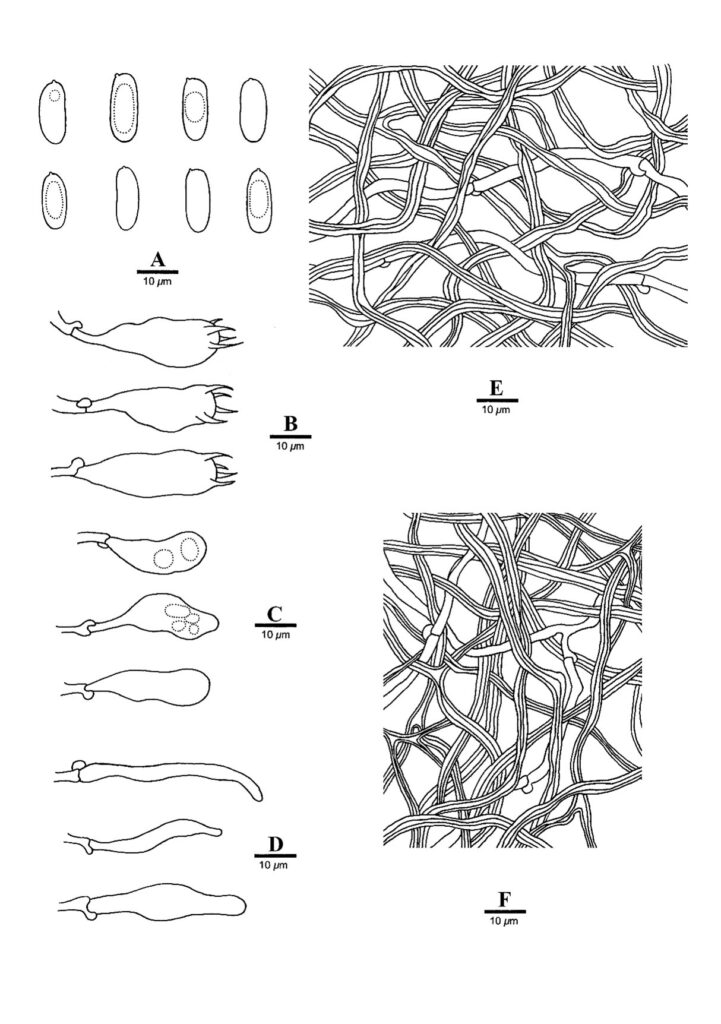Megasporoporiella australiae
MycoBank number: MB 558814; Index Fungorum number: IF 558814; Facesoffungi number: FoF 10473;
Description
Basidiocarps annual, resupinate, corky, without odor or taste when fresh, becoming hard corky and cracked upon drying, up to 5.4 cm long, 2 cm wide, and 0.4 mm thick at center; sterile margin distinct, white to cream, cottony, up to 3 mm wide. Pore surface white to cream when fresh, vinaceous buff to fulvous when dry; pores round to angular, 3–4 per mm; dissepiments thick, entire; subiculum pale buff, corky, up to 0.2 mm thick; tubes cream, paler than subiculum, corky, up to 0.2 mm long. Hyphal system dimitic; generative hyphae bearing clamp connections; skeletal hyphae IKI–, CB+; tissues unchanged in KOH (not dissolved). Subicular generative hyphae infrequent, hyaline, thin-walled, occasionally branched, 2–3 µm in diam; skeletal hyphae dominant, thick-walled with a narrow to medium lumen, frequently branched, strongly flexuous, strongly interwoven, 2–3.5 µm in diam. Tramal generative hyphae hyaline, thin-walled, occasionally branched, 2–2.5 µm in diam; skeletal hyphae dominant, thick-walled with a narrow lumen, moderately branched, strongly flexuous, strongly interwoven, 2–3 µm in diam. Dendrohyphidia absent. Hyphal pegs absent. Cystidia absent; cystidioles present, tubular to fusoid, thin-walled, smooth, 29–41 × 2.5–11.5 µm. Basidia pear-shaped, with four sterigmata and a basal clamp connection, 35–38 × 9.5–12 µm; Basidioles in shape similar to basidia, but smaller, some with a few guttules. All the hymenial cells (cystidioles, basidia and basidioles) with abundant oily substance. Small tetrahedric or polyhedric crystals frequently present among hymenium. Basidiospores cylindrical, hyaline, thin-walled, smooth, sometimes with one big guttule, IKI–, CB–, (11.5–)11.8–15(–16.5) × (3.5–)4–6(–6.5) µm, L = 13.4 µm, W = 4.98 µm, Q = 2.52–2.64 (n = 60/2).
Material examined: Australia. Melbourne. Dandenong Ranges Botanic Garden, on dead tree of Rhododendron, 12 May 2018, Y.C. Dai 18657 (BJFC27125, holotype), Y.C. Dai 18658 (BJFC27126).
Distribution: Australia. Melbourne.
Sequence data: Dai18657 (Holotype) – ITS: MW694888.1 (ITS5/ITS4); LSU: MW694931.1 (LROR/LR7); MTSSU: MW694916.1 (MS1/MS2); EF1a: MZ618634.1 (983F/1567R); Dai18658 – ITS: MW694889.1 (ITS5/ITS4); LSU: MW694932.1 (LROR/LR7); MTSSU: MW694917.1 (MS1/MS2); EF1a: MZ618635.1 (983F/1567R);
Notes: Morphologically, Megasporoporiella australiae resembles Megasporia cystidiolophora, Megasporia hengduanensis and Megasporoporia cavernulosa by sharing almost the same size of pores and basidiospores, but the latter three species can be readily distinguished from Megasporoporiella australiae by their dextrinoid skeketal hyphae (Ryvarden et al. 1982, Cui & Dai 2007, Li & Cui 2013b). Phylogenetically, M. australiae is closely related to M. rhododendri (Figs. 1, 2), but M. rhododendri can be distinguished from M. australiae by dextrinoid skeletal hyphae and ellipsoid basidiospores measuring as 11–14 × 6.5–8 µm (Dai et al. 2004).

Fig. 1. Megasporoporiella australiae (paratype). Basidiocarps of Megasporoporiella australiae (the paratype, Dai 18658).

Fig. 2. Megasporoporiella australiae (holotype). Microscopic structures of Megasporoporiella australiae (drawn from the holotype, Dai 18658). (A) Basidiospores; (B) Basidia; (C) Basidioles; (D) Cystidioles; (E) Hyphae from subiculum; (F) Hyphae from tube.
